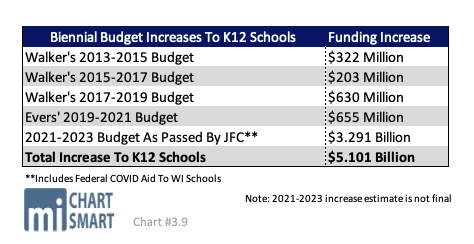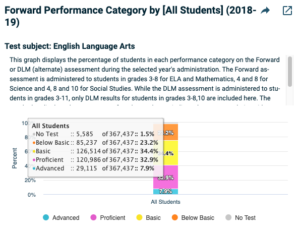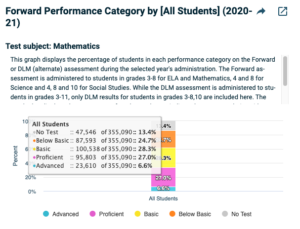
DPI just released the most recent proficiency scores for Wisconsin students, shocking how far proficiency rates fell, and more concerning is that we are trending the wrong way
Despite historic levels of state taxpayer support for K12 education the last three budgets and a massive $2.6 billion of federal Covid-19 aid to prevent learning loss, Wisconsin students see a precipitous drop in proficiency rates
Less than a third of students are proficient or operating at grade level in math or English Language Arts
By Abbi Debelack and Brett Healy
The latest data on testing and proficiency rates for Wisconsin’s children were released by the Department of Public Instruction on Wednesday and it is not pretty.
Each year, Wisconsin students in various grades take a series of standardized tests to assess their proficiency in a range of different subjects. Test results are a useful tool to track a student’s academic progress and gauge the overall effectiveness of Wisconsin’s K12 education system. The Forward Exam is given to students in grades three through eight and ten. The ACT Aspire test is given in grades nine and ten. The ACT writing test is given in grade eleven and the Dynamic Learning Maps is given to students with cognitive disabilities. This year, the tests were administered to students in the spring. The tests were not administered in 2020 because of COVID-19.
This year, English Language Arts (ELA) proficiency is 27.5%, down 5.4 points or a 16.41% reduction from 2019. Math proficiency is at 27%, down 7 points from 2019 or a 20.59% reduction. These figures look at proficiency rates as a percentage of TOTAL Wisconsin students, not just those tested as Superintendent Underly reported in her press release.
We must point out that this is not a particularly difficult or rigorous grading metric. A student who is graded as being proficient on the Forward Exam means the child is operating at grade level. Let that sink in. Shockingly, less than one-third of Wisconsin students are proficient in math or English Language Arts.

What is even more alarming than the fact that less than a third of our students are not proficient in math or English is the percentage of our students that score BELOW the proficient line, at the “basic” or “below basic” levels.
According to the DPI website, a student who earns a basic rating on the Forward Exam “demonstrates some academic knowledge and skills tested on the statewide standardized test.” A student who earns a below basic rating on the Forward Exam “demonstrates little academic knowledge and skills tested on the statewide standardized test.”
In 2021, 53% of students who took the Forward Exam earned a basic or below basic designation in ELA and/or math. Fifty-three percent!
In Wisconsin, we have over 50% of our students between grades 3-10 who FAIL this important benchmark.
Think about that for a second. Where is the outrage?
Students undoubtedly faced challenges last year, but one of the purposes of the $2.6 billion in federal covid aid for Wisconsin schools was so that K12 education would continue in earnest and that the education establishment would have the resources and tools to do everything possible to prevent learning loss.

Looks like we failed many of our kids once again.
The education establishment will certainly make all sorts of excuses to downplay this catastrophe but it cannot be blamed on a lack of support from taxpayers. Education funding in Wisconsin is at historic levels. Wisconsin taxpayers have increased state support for K12 education by over $2 billion in recent years and federal taxpayers sent an unprecedented and unthinkable $2.6 billion to Wisconsin schools since the start of the pandemic. Everyone knew that educating our children during COVID-19 would be a challenge and require additional resources. Taxpayers stepped up to provide that support and gave the education establishment everything they needed to do their job but they failed miserably.


Almost as concerning as the low number of children who are operating at a failing or proficiency level is the high number of students who did not take the test this year. According to DPI, around 487,000 students, or only about 84% of Wisconsin’s 580,000 students took the math and ELA exams. In past years, according to DPI, participation was generally above 95%.
For context, we have approximately 830,000 K12 students enrolled in public schools this year and 120,000 in private schools.
Some of the state’s largest districts had alarmingly high rates of students who did not take the Forward Exam. In Milwaukee Public Schools (MPS), 56% of students did not take the ELA test in 2021, compared to 1.5% who did not take the same test in 2019. Madison Schools saw a similar trend with 50% of students not taking the ELA test in 2021, compared to 4.7% in 2019. Other large districts had slightly better turnout with only 8.2% of students in La Crosse, 8.6% of students in Wausau, 18.1% of students in Racine, and 26.2% of students in Green Bay not completing the ELA test in 2021.

State Superintendent Underly, head of the Department of Public Instruction and the elected official in charge of K12 education here in Wisconsin, tried to explain away the dismal scores. In a press release, Underly commented that “Participation and proficiency rates look different than other years, and that is not surprising considering the extraordinary circumstances and challenges faced everywhere in our state, including schools and districts.”
We at MacIver have been demanding for over a year that Governor Evers and our top education officials talk about learning loss and the actions needed to help our children meet this challenge.
In a piece titled, The Lost Year Of Learning – What Wisconsin Needs To Do To Keep Our Children From Falling Further Behind, MacIver lists many action items members of the education establishment could have taken to prevent this loss from occurring. From extending the 2021-2022 school year, adding extra instructional time to the school day, eliminating optional elective courses, to requiring students who were falling behind to get extra help through tutors or summer school, there were a number of different ways to prevent this learning loss from happening.
However, former DPI Head Standford Taylor did not have a plan. Gov. Evers did not include a detailed plan in his 2021-2023 budget. Newly-elected Superintendent Underly has spent most of her time talking about the need to implement the racist Critical Race Theory in our schools and pushing mediocrity on our children rather than using the bully pulpit to raise awareness about this critical problem.
These dismal results come less than a month after Superintendent Underly’s State of Education Address where she made no mention of the staggering decline in proficiency rates or even focus on learning loss. At the time Underly said that “We need to give school staff and school board members grace and the support they need as they work to keep kids safe and avoid disruptions in learning.”
Underly must have known at the time of her speech that this year’s Forward Exam results were a disaster and, yet, she choose to focus on Critical Race Theory.

This is a huge problem that should not and cannot be ignored or dismissed. It’s not pleasant or easy to hear the sad truth about the poor performance of our children but it is a vital conversation we must have and keep at the forefront until we fix the problem. Talking openly about academic achievement, real academic performance, not wokeness or equity is the only way we can give our children a fighting chance. We cannot address the problem or even begin to address the problem if we cannot be honest with ourselves about the dismal performance of our children and our schools.
Parents and taxpayers need to stand up, speak out and demand better of our children, our teachers, our administrators, and our elected officials. Our children are depending on us to fix K12 education.
The Department of Public Instruction’s next big data drop will be in late November when the school report card data will be released.



